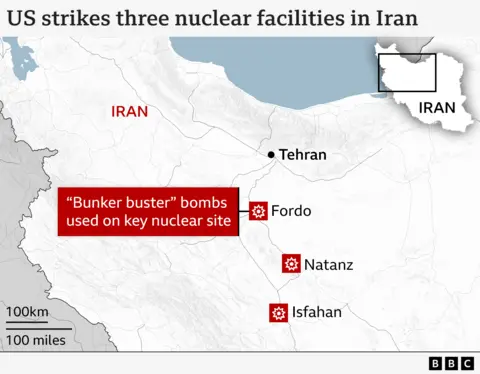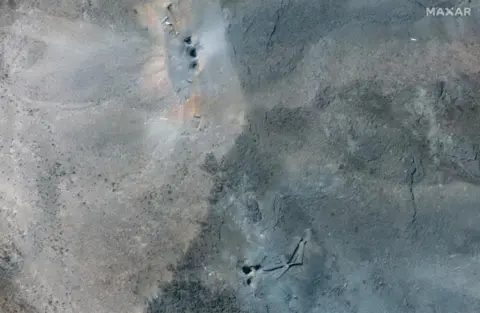BBC News
 Maksar Technology
Maksar TechnologyPresident Donald Trump says that they have now implemented a “successful” bombing attack on three nuclear places in Iran and they are “removed”.
The Pentagon said on Sunday that it would take time to fully assess the effect of attacks, although all locations that were held “extremely difficult damage” appears.
Israel says they were in “full coordination” with the US in planning strikes. Iranian officials confirmed that the benefits were affected, but negated that he suffered a big blow.
Strikes mark significant escalation in the current war between Iran and Israel.
Here’s what we know.
What was now bombing and what weapon used?
The American Gene Day Caine, the president of the joint heads of the staff, said the precision hammer operation, included 125 American military aircraft, including seven B-2 covered bombers.
Three nuclear plants – Fordo, Natanz and Isfahan were targeted, said now.
During Pentag’s briefing, Caine said that bombers started from the US at a 18-hour flight, and some went west in a peaceful pacifica as a “decoy”, while he found the main streaker’s seven B-2 bombers in Iran.
Just before the plane entered Iranian airspace, more than two dozen Tomahawk’s targets on targets in Isfahan were launched from the American submarine rocket, he said.
As bombers entered Iranian airspace, now “Several Tactics, including decors,” with combat nozzles, “cleared the airspace, checking enemy planes and rockets to enemy and air, Caine said.
Lead B-2 then fell two GBU-57 mass slots (MPS) – known as “Bunker Buster” Bombs – on the nuclear page on Ford. Caine said that a total of 14 mops fell on two target areas.
All three Iran nuclear infrastructure was hit between 18:40 Eastern Time (23:40 BST) and 19:05 Eastern Time (00:05 BST) said Caine.
Bombers then went out Iranian airspace and started returning to the US.
“Iranian fighters did not fly and did not see us rocket systems of Iranian air,” Caine said.
Speaking on the same briefing, the Secretary of Defense of Pete Hegseth said the operation did not target Iranian troops or Iranian people.
He added that the mission “did not, and did not deal with the change in the regime”.
The Secretary of Defense said he recognized “our allies in Israel” for the given support, adding that the operations lasted months and weeks of planning.

Hidden in a remote mountain, a foro nuclear site includes a plant enrichment plant that is vital for Iran nuclear ambitions.
It is located south of Tehran, it is believed to be deeper underground from the canal tunnel, which connects great and France.
Due to Ford depth below the earth, they only now have a type of “Bunster Buster” bomb large enough to penetrate the location.
Weigh 13,000 pounds (30,000lb) and can fall through about 18m (60ft) concrete or 61m (200ft) the country before the explosion, according to the experts.
Due to the depths of Ford tunnels, the MOP is not guaranteed that it is successful, but the only bomb that could be approached.
Caine confirmed that between seven bombers of B-2 spirit, 14 cloth bombs were among “75 precisely guided weapons” used in the strike against Iran.

What is known about the impact of the attack?
Gen Caine said it would need some time to fully assess the scope of damage caused by the US attack.
But he said, “The initial assessment of damage in combat shows that all three places have gained extremely serious damage and destruction.”
New satellite images recorded 22. June shows six fresh craters on the Ford’s nuclear page, probably input points for American ammunition, as well as gray dust and debris scattered down the mountains.
 Maksar Technology
Maksar TechnologyAfter confirming the US that the Pugs were used in the attack, a higher image analyst, Stu Rai, said the BBC is verified: “You will not see a huge explosion at the entrance, but deeper in the entry.”
He added that three separate ammunition seems to fall into two separate impact points and that the gray color in the field shows that the concrete remains of the explosion.
Mr. Rai also said that they were entering the tunnel blocked. Since there are no visible crumbers or impact points near them, he suggests that it may have been an Iranian attempt to “alleviate the intentional targeting of air bombing.”
The Iranian Atomic Energy Organization said the bombing of three nuclear locations was a “barbarian violation of international law.
Both Saudi Arabia and UN Nuclear Nuclear International Atomic Energy Agency (IAEA) say there is no growth of radiation levels after the attack.
Deputy Political Director of the Iranian State Broad, Hassan Abedini said Iran evacuated these three nuclear sites “, before time”. Appearing on state television, he said Iran “did not suffer a big blow because the materials were already taken out.”
How would Iran move away?
During the US bombing, Iran launched a fresh rocket barrage that hit parts of Tel Aviv and Haif. At least 86 people were injured, officials said.
On Sunday, Iranian President Masoud Peseshkian said that the United States “must receive a response to their aggression.”
“We always stated that we are ready to get involved and negotiate within international law, but instead of accepting the logic, the other party requested the surrender of the Iranian nation,” he said in the statement.
Safety correspondent BBC Frank Gardner says Iran must now choose between three strategic coursework courses in response to the US attack overnight:
- Don’t do anything. That could spare that from further American attacks. He could even choose a diplomatic route and re-join the negotiations with the US. But it doesn’t do anything, Iranian regime looks weak, especially after all of their warnings of Ritera consequences, if they attacked. It can decide the risk of weakening their population over their population outweighs the cost of further American attacks
- Revenge hard and quickly. Iran still has significant arsenal ballistic rockets after production and hiding them for years. It has a target list of about 20 American databases that would choose between the wider Middle East. It could also start “Svrst Pre-Attacks” on American Navy War Boats using drone and fast torpedo boats
- Rest later in time on your own choice. It would mean waiting until the current tension hit and triggered the surprise attack when they were basically no longer at maximum warning
What did Donald Trump say and how did American politicians react?
Publishing on its eastern platform at 19:50 Eastern Time (00:50 BST), Trump confirmed strikes in Ford, Natanz and Isfahan.
Just over two hours later, and that Vice President JD Vance, Secretary of State Secretary, Marko Rubio and Hegeth, Trump made a television address.
He said the future attacks would be “far greater”, unless Iran reached a diplomatic solution.
“Remember, there’s a lot of targets left,” he added.
Several Trump fellow republics published statements in support of the move, including Texas Senator Ted Cruz, who “praised the President”.
Senator Mitch McConnell, the establishment of republicans who occasionally was highly critical to Trump, called “prudent heat response to Tehran”.
Not every Republican supported so much, with Georgia Congress Marjorie Taylor Greene, usually trump Stalvart, saying “This is not our struggle.”
Republican Congressman Thomas Massie, who earlier this week, introduced an account that would block Trump to attack Iran without the approval of the law, he should have called strikes’ not constitutionally. In the social media site, Trump called Massie “pathetic loser.”
The article and Constitution of the United States sets the power to declare a war in the hands of congress, ie legislators elected in the House of Representatives and the Senate.
But a member II says that President is the main commander of the armed forces and grants him powers to order military force to defend American American against real or predicted attacks.
The leading American Democrat Hakeem Jeffries said Trump risked us “twisted into a potentially catastrophic war in the Middle East”, while others were accused of bypassing Congress to launch a new war.
How did world leaders react?
UK, France and Germany called on Iran to avoid any action that could further “destabilize” the Middle East.
In a common statement, British Prime Minister Sir Keir Starmer, French President Macron and German Chancellor Friedrich Merz said they were “consistently clearly that Iran could never have nuclear weapons” and they supported the security of Israel.
The UN Secretary-General Antonio Guterres said that the American air attacks were dangerous escalation, while the European Union was director Kaja Kallas to pull and return in the negotiating table.
Saudi Arabia has expressed “great concern” while Oman condemned strikes and called for de-escalation.
Indian Prime Minister Narendra Modi said he was talking to Iranian President Masom Pezeshim and called for “dialogue and diplomacy as a way forward.”
Russian politician Dmitry Medvedev, ally by President Vladimir Putin, said: “Trump, who entered the president of the peacemaker, started a new war for the United States.
“Such success, Trump will not win the Nobel Peace Prize.”
How did this start?
Israel began a surprise on the attack on dozens of Iranian nuclear and military goals 13. June. They said that his ambition was to dismantle his nuclear program, who said that Prime Minister Benjamin Netanyah would soon be able to produce a nuclear bomb.
Iran insists that her nuclear ambitions are calm. In retaliation, Tehran launched hundreds of rockets and drones in Israel. The two countries continued to exchange strikes since, in the air war, which has now lasted for more than a week.
Trump has long said to oppose Iran that possesses nuclear weapons. Israel is widely believed to have them, although it does not even confirm it.
In March, the American National Intelligence Directorate Tulsi Gabbard said that Iran increased uranium supplies to unprecedented levels, he did not build a nuclear weapon – it was recently said that it was “wrong” wrong. “
At the trail of the campaign, Trump criticized in addition to American administrations for engaging in “Dumb Infinite Wars” in the Middle East and promised to keep America from foreign conflicts.
The US and Iran were in nuclear negotiations at the time of the surprise of Israela surprises. Just two days ago, Trump said that Iran would give two weeks to enter significant negotiations before intruding – but that the time line proved much shorter.






